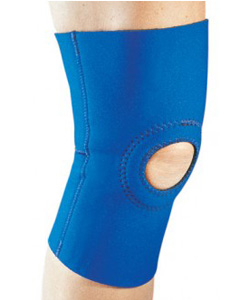Please choose a body region on the right for you to pin point the problem area of your body.

Shop by Condition

Shop by Brand
By Nancie George
Severe pain, joint stiffness, and swelling are just a few of the symptoms you can expect with arthritis. The condition may also put you at greater risk for mental health issues like depression and loneliness, but the forecast doesn’t have to be so gloomy. To gain insight into how to live a full life while managing the disease, we asked four successful, productive people — who also happen to have chronic arthritis — to share the strategies that keep them both physically and mentally strong. Their tips may inspire you even if you don't have the condition.
“I think the first mistake I made was believing that life as I knew it was over," says Seamus Mullen, award-winning chef, restaurateur, and author of Hero Food . "I really felt as though the rug was pulled out from beneath me, and that I would never again be able to do the things I once loved doing.”
In 2007, after experiencing chronic pain throughout his body, Mullen was diagnosed with rheumatoid arthritis. The condition occurs when the immune system attacks tissue in joints, causing inflammation — and possibly also affecting other organs in the body. “I really wish that, early on, I'd gotten to know more people who were living and functioning with RA, and that I'd learned more about what I could do as an individual to treat the disease, rather than depending so heavily on the medical community for answers,” Mullen explains.
If you’re a young person who has just received a diagnosis, understand that you aren’t alone. Triathlete Dina Neils of Elk Grove, California, was diagnosed with RA at age 18 during her freshman year of college. After Neils’s diagnosis, her doctor told her that she would never run again and would be in a wheelchair by her mid-twenties. “I wish I would have educated myself more about the disease, and about online communities like CreakyJoints,” says Neils, who also produces the RA blog Titanium Triathlete.
Athlete and Racing for a Cure ambassador Aimée Espinoza of San Clemente, California, was first diagnosed with juvenile RA at age 14. Now 27, Espinoza says she wishes she'd gotten a second opinion at the time from another rheumatologist. “But I was so desperate for answers and a quick solution that I did whatever my rheumatologist told me to do. I took medication without asking questions, without researching, and without knowing what the side effects might be for me,” says Espinoza, who also writes the blog Fit Aimée RA.
In 2003, Alan Brewington of Boise, Idaho, fell 15 feet while rock climbing. The fall took a devastating toll on his body, and over the next few years, he experienced chronic pain and endured numerous corrective surgeries. “As a chronic pain and arthritis patient, it's sometimes incredibly difficult to see past today,” says Brewington, who later founded Pain Talks, a site that uses arthritis patient's stories to help educate others about the disease.
|
|
Before her RA diagnosis, Neils was an accomplished long distance runner headed for collegiate competition. She was diagnosed with RA during her freshman year of college. Neils says her greatest challenge physically was not being able to run anymore. “After being angry and in denial about it, I learned that I had to accept what was happening to my body. I overcame my physical challenges by changing my mind-set, which helped me become mentally strong,” she says.
“By far the biggest challenge was figuring out what I could and couldn’t do,” says Mullen, chef and owner behind the popular NYC restaurant Tertulia. “Over time, I came to realize that there was a lot I could do in terms of my diet and lifestyle to curb the effects of the disease and, in my case, eventually get off medication and stop having symptoms, or even showing markers in my blood. This was a tremendously difficult path, but one that paid off,” says Mullen. If you’re interested in changing or stopping medications, first talk to your doctor, who can help guide you down the right path.
RELATED: Best Foods for a Healthy Immune System
After her RA diagnosis, Espinoza had difficulty accepting that she now had a chronic health condition that could affect any organ in her body. “I really thought I wouldn't be affected by the disease, but I soon learned that I was not invincible — pain, fatigue, and depression took over the person I was,” she says.
“The biggest challenge for me since my diagnosis has been remembering that attitude is a choice, and not something that pain gets to decide,” Brewington says. He experienced severe pain after his diagnosis, and responded by vegging out on the couch. “I thought the best choice of action was to shut down both physically and mentally on bad days, but now I know I have many more options than that,” he says.
“Starting from the moment of diagnosis, when you learn that you have a lifetime disease, it's all very surreal,” says Espinoza. “So you need to have patience with yourself, because some things that were easy before, like taking a shower, are going to be challenging in the future.”
|
|
“As patients, we've earned the right to have bad days. And especially since this is a chronic condition, bad days will happen,” says Brewington. “But just because it’s a bad day doesn't mean you have a bad life. I still ski, work full-time, road bike, own a house, travel, run Pain Talks, hike, and advocate because I choose to define my life as a patient — my disease just gets to enjoy the ride!”
“Educate yourself about the disease, and work with your team of physicians to reach your quality-of-life goals,” says Neils. Espinoza also recommends getting a second opinion from another rheumatologist, but if you can't find another one to speak with, you may want to talk to your regular physician about your concerns.
![]()
After an arthritis diagnosis, find a credible online support group to learn what it’s really like to live with the disease, says Espinzoa. “The online community will become your family, and you'll make friends all over the world who battle the same disease. We all understand one another, we offer support to one another, and we help solve issues together,” Espinoza says.
Neils recommends the arthritis patient community site CreakyJoints for its accurate and informative resources and supportive group members.
Brewington found support by searching social media sites for people in similar health situations. “There's always a fellow patient or advocate willing to talk almost 24 hours a day, 7 days a week. Great hashtags to follow on Twitter include #chroniclife, #painsomnia, or #spoonie. We are all here to help and support, just ask,” he says.
And remember that you’re not alone, says Mullen. “It can feel awful to be alone, but there are many others that truly understand what you’re going through. Find them, meet them, and share your story with them.”
| Stay Connected! |
Related Articles
Get $10 off your next order when you sign up to receive our email newsletter.*
Simply enter your email address below!
*Minimum order value of $100. Valid email address to qualify.


 This
This 





